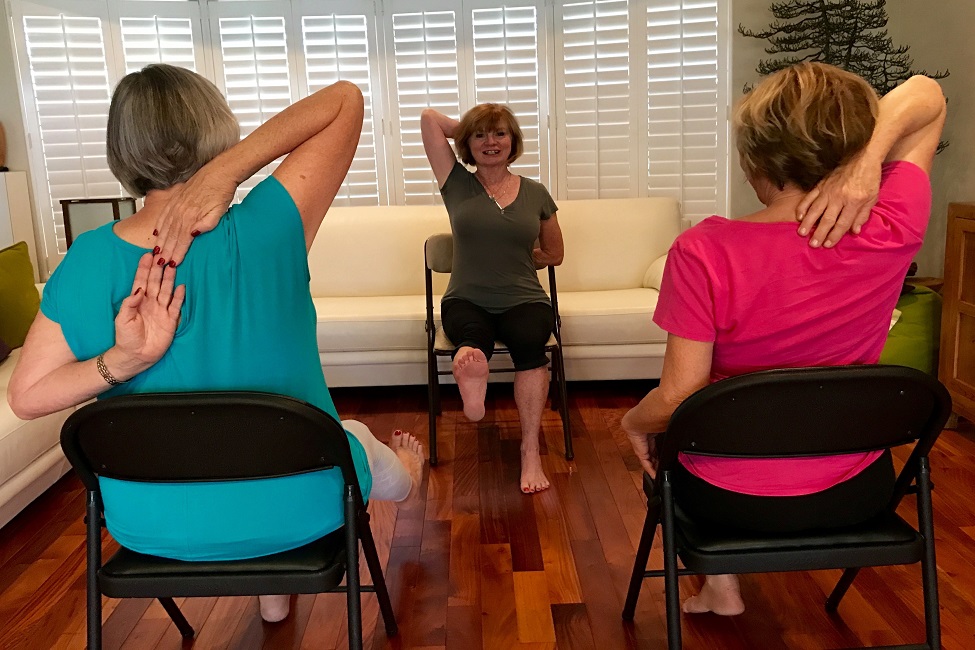Chair Yoga Effective Way to Treat Osteoarthritis
The first study to examine the effects of chair yoga on pain and physical function in older adults with osteoarthritis is proving to be an effective way to reduce pain and improve quality of life.

The overall goal of this interdisciplinary program is to decrease pain, and improve physical and psychosocial functions of elderly individuals with osteoarthritis who are unable to participate in other exercise and yoga programs.
For the millions of older adults who suffer from osteoarthritis in their lower extremities (hip, knee, ankle or foot), chair yoga is proving to be an effective way to reduce pain and improve quality of life while avoiding pharmacologic treatment or adverse events. A new study, conducted by researchers at Florida Atlantic University and published in the current issue of the Journal of the American Geriatrics Society ,is the first randomized controlled trial to examine the effects of chair yoga on pain and physical function in older adults with osteoarthritis.
For the study, researchers randomly assigned 131 older adults with osteoarthritis to either the “Sit ‘N’ Fit Chair Yoga©” program developed by Kristine Lee or a health education program. Participants attended 45-minute sessions twice a week for 8 weeks. Researchers measured pain, pain interference (how it affects one’s life), balance, gait speed, fatigue and functional ability, before, during and after the sessions.
Results from the study found that participants in the chair yoga group, compared to those in the health education program, showed a greater reduction in pain and pain interference during their sessions, and that reduction in pain interference lasted for about three months after the 8-week chair yoga program was completed. The 8-week chair yoga program also was associated with reductions in fatigue and improvement in gait speed during the study session, but not post session.
“With osteoarthritis-associated pain, there is interference in everyday living, limiting functional and social activities as well as diminishing life enjoyment,” said Juyoung Park, Ph.D., co-author and co-principal investigator of the study, Hartford Geriatric Social Work Faculty Scholar and an associate professor in FAU’s College for Design and Social Inquiry. “The effect of pain on everyday living is most directly captured by pain interference, and our findings demonstrate that chair yoga reduced pain interference in everyday activities.”
Regular exercise has proven to help relieve osteoarthritis pain, however, the ability to participate in exercise declines with age, and many dropout before they can even receive benefits. Although the Arthritis Foundation recommends yoga to reduce joint pain, improve flexibility and balance, and reduce stress and tension, many older adults cannot participate in standing exercises because of lack of muscle strength, pain and balance as well as the fear of falling due to impaired balance. Chair yoga is practiced sitting in a chair or standing while holding the chair for support, and is well suited to older adults who cannot participate in standing yoga or exercise.
“Currently, the only treatment for osteoarthritis, which has no cure, includes lifestyle changes and pharmacologic treatments that are not without adverse events,” said Ruth McCaffrey, D.N.P., A.R.N.P., co-author and emeritus professor in FAU’s College of Nursing. “The long-term goal of this research is to address the non-pharmacologic management of lower extremity osteoarthritis pain and physical function in older adults, and our study provides evidence that chair yoga may be an effective approach for achieving this goal.”
The overall goal of this interdisciplinary program is to decrease pain, and improve physical and psychosocial functions of elderly individuals with osteoarthritis who are unable to participate in other exercise and yoga programs.
Park and McCaffrey conducted the study with Patricia Liehr, Ph.D., R.N., co-principal investigator, co-author and a professor in FAU’s College of Nursing; David Newman, Ph.D., co-author and an assistant professor in FAU’s College of Nursing; and Joseph G. Ouslander, M.D., co-author, senior associate dean of geriatric programs and chair and professor of the Department of Integrated Medical Science in FAU’s Charles E. Schmidt College of Medicine.
“The potential impact of this study on public health is high, as this program provides an approach for keeping community-dwelling elders active even when they cannot participate in traditional exercise that challenges their balance,” said Liehr.
Osteoarthritis is the most common form of arthritis in older adults. Consequences associated with osteoarthritis include pain, joint stiffness and functional limitation of activities of daily living. Osteoarthritis is the leading cause of long-term disability among older adults and affects more than 33 percent of people over the age of 65 in the U.S. Annually, osteoarthritis accounts for more than 11 million physician and outpatient visits, 662,000 hospitalizations and an estimated $81 billion in costs for medical and surgical treatments. The World Health Organization estimates that osteoarthritis affects about 10 percent of men and 18 percent of women worldwide.
This project is supported by the National Institutes of Health (NIH)/National Center for Complementary and Integrative Health (NCCIH) through grant number 1R15AT007352-01A1.
-FAU-
Tags: nursing | faculty and staff | medicine | research | cdsi